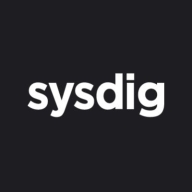


Sysdig Secure and Google Cloud Security Command Center compete in the cloud security solutions category. Sysdig Secure has a slight edge with user satisfaction with pricing, whereas Google Cloud Security Command Center is recognized for its advanced features.
Features: Users value Sysdig Secure's integration capabilities, real-time monitoring, and ease of use. Google Cloud Security Command Center is noted for its threat detection, advanced analytics, and extensive feature set.
Room for Improvement: Sysdig Secure users request better alerting mechanisms, more comprehensive documentation, and enhanced scalability. Google Cloud Security Command Center users seek improvements in its learning curve, user interface, and real-time capabilities.
Ease of Deployment and Customer Service: Sysdig Secure is known for its straightforward deployment and responsive support team. Google Cloud Security Command Center's deployment process is more complex, though it offers extensive and highly rated support.
Pricing and ROI: Sysdig Secure users find the pricing model favorable with good ROI. Google Cloud Security Command Center has a higher initial cost but users recognize its value for the extensive features provided.
| Product | Market Share (%) |
|---|---|
| SentinelOne Singularity Cloud Security | 4.7% |
| Sysdig Secure | 3.3% |
| Google Cloud Security Command Center | 2.8% |
| Other | 89.2% |

| Company Size | Count |
|---|---|
| Small Business | 47 |
| Midsize Enterprise | 20 |
| Large Enterprise | 53 |
| Company Size | Count |
|---|---|
| Small Business | 6 |
| Midsize Enterprise | 2 |
| Large Enterprise | 5 |
SentinelOne Singularity Cloud Security offers a streamlined approach to cloud security with intuitive operation and strong integration capabilities for heightened threat detection and remediation efficiency.
Singularity Cloud Security stands out for its real-time detection and response, effectively minimizing detection and remediation timelines. Its automated remediation integrates smoothly with third-party tools enhancing operational efficiency. The comprehensive console ensures visibility and support for forensic investigations. Seamless platform integration and robust support for innovation are notable advantages. Areas for development include improved search functionality, affordability, better firewall capabilities for remote users, stable agents, comprehensive reporting, and efficient third-party integrations. Clarity in the interface, responsive support, and real-time alerting need enhancement, with a call for more automation and customization. Better scalability and cost-effective integration without compromising capabilities are desired.
What are SentinelOne Singularity Cloud Security's standout features?SentinelOne Singularity Cloud Security is deployed in industries needing robust cloud security posture management, endpoint protection, and threat hunting. Utilized frequently across AWS and Azure, it assists in monitoring, threat detection, and maintaining compliance in diverse environments while providing real-time alerts and recommendations for proactive threat management.
Google Cloud Security Command Center streamlines security management by providing comprehensive visibility into asset security posture, empowering organizations to identify vulnerabilities and threats effectively.
Google Cloud Security Command Center offers a centralized platform for organizations to manage their security landscape, providing tools like threat detection and vulnerability scanning to protect cloud assets. Users benefit from its integration capabilities and detailed reporting, which enhance their ability to combat security challenges efficiently.
What are the key features of Google Cloud Security Command Center?Industries such as finance and healthcare benefit significantly from Google Cloud Security Command Center, as it helps them maintain compliance with strict regulations. Its ability to provide detailed security assessments and support integration with other cloud services makes it an essential tool for protecting sensitive data and ensuring uninterrupted service to customers.
In the cloud, every second counts. Attacks move at warp speed, and security teams must protect the business without slowing it down. Sysdig stops cloud attacks in real time, instantly detecting changes in risk with runtime insights, a unique AI architecture, and open source Falco. Sysdig delivers live visibility by correlating signals across cloud workloads, identities, and services to uncover hidden attack paths. By knowing what is running, teams can prioritize the vulnerabilities, misconfigurations, permissions, and threats that matter most. From prevention to defense, Sysdig helps enterprises move faster and focus on what matters: innovation.
Sysdig. Secure Every Second.
We monitor all Cloud-Native Application Protection Platforms (CNAPP) reviews to prevent fraudulent reviews and keep review quality high. We do not post reviews by company employees or direct competitors. We validate each review for authenticity via cross-reference with LinkedIn, and personal follow-up with the reviewer when necessary.